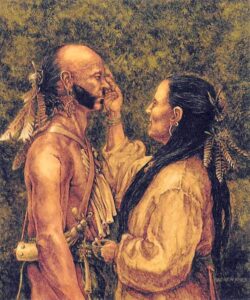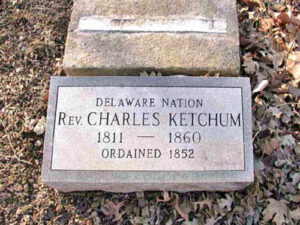White Church, Kansas, located nearly in the center of Wyandotte County, was one of the earliest settlements in the area. An extinct town today, it was located about ten miles west of the town of Wyandotte.
A Methodist mission was established on the future town site among the Delaware Indians in 1832 by Reverend Thomas Johnson, his brother, Reverend William Johnson, and Reverend Thomas Markham.
These three men were tasked with directing the mission school, Indian Mission, and the church. Though these institutions were intimately connected, they were separate institutions. The first church was built near a spring in a beautiful grove of trees. It was a log building measuring about 40 by 60 feet, framed in black walnut. The church was painted white, causing the Indians to call it the “White Church.”
After the Mission was established, the Reverend Thomas Johnson turned it over to his brother, the Reverend William Johnson, and the Reverend Thomas Markham.
Prominent among the Delaware Indians was Charles Ketchum, who would later become a preacher in the Methodist Church. Though he was illiterate, he was intelligent and a fluent talker. He began preaching in the Indian language at White Church. He also occasionally preached at Wyandotte to a portion of Delaware after their removal to the Indian Territory (Oklahoma.) He was considered one of the most eloquent orators in the tribe. His brother, the Reverend James Ketchum, is known as the first ordained minister of the Delaware nation.
In 1844, the original church was destroyed by fire, and a new church was built that was much the same as the first church.
In 1845, just after the second church was built, a split occurred in the Methodist Church congregation over slavery. At that time, the Ketchum brothers did not agree on affiliation. James remained with the southern branch of the White Church, and Charles was affiliated with the northern branch and built a new church.
Beginning in 1850, the land of the Delaware Reservation was deeded by the government to the Indians individually. Some sold their ground, and soon, the area began to be settled by white men.
In 1854, Congress passed the Kansas–Nebraska Act, which created Kansas Territory and opened the area for white settlement. Within no time, hundreds of whites were trespassing, cutting timber, and building houses on the tribes’ land. They were reluctant to negotiate for another relocation but feared severe trouble with white settlers. By 1860, the Delaware had reached a consensus to leave Kansas, and the tribe purchased land from the Cherokee Nation and established their headquarters near present-day Bartlesville, Oklahoma. When they left in 1867, they numbered 1,160.
A Presbyterian Church was organized on April 19, 1869, with a membership of 40 and A. A. Allen as pastor. There were two Sunday schools in the building with an average attendance of 30. A public school was maintained in the church for 13 years with an average attendance of 25 students.
A post office, also called White Church, was established on April 22, 1869.
In 1870, a school district was established, and a school located near the church was White Church School.
A Masonic Lodge was chartered on October 20, 1870, with a membership of 25.
Disaster struck the church for a second time on May 11, 1886; a wind storm destroyed the White Church and the original White Church School building.
The following year, in 1887, a two-story school building was erected on the White Church Elementary School site. For almost 20 years, the congregation of White Church would be without a church building, holding services in the school building.
In the early 1880s, the village of White Church had a good school, a Masonic hall, two churches, and half a dozen stores. The nearest train station was four miles north in Pomeroy.
In May 1904, work began on a new White Church. The church was completed for $12,000 and was dedicated on July 29, 1906. It was built of stone, hauled by teams and wagons from a nearby quarry.
Its post office closed on January 15, 1907.
In 1910, White Church was the supply and shipping point for a rich agricultural district. At that time, it had general stores, express and telegraph facilities, rural free mail delivery from Bethel, and a population of 152.
Today, the historic White Church still serves a congregation. Historians recognize it as the oldest established church in Kansas that is still in use. The church also owns and cares for the Delaware Indian Cemetery, located directly west of the church. The cemetery is the oldest cemetery in this area, where burials are still conducted. The earliest recorded burial was in 1831. Its current church bell was purchased on April 1, 1933, for $20.00.
The church is at 2200 N 85th Street in Kansas City, Kansas.
©Kathy Alexander/Legends of Kansas, updated October 2023.
Also See:
Extinct Towns in Wyandotte County
Wyandotte County Photo Gallery
Sources:
Blackmar, Frank W.; Kansas: A Cyclopedia of State History, Vol I; Standard Publishing Company, Chicago, IL 1912.
Cutler, William G; History of Kansas; A. T. Andreas, Chicago, IL, 1883.
White Church Christian Church




